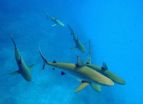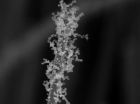(Press-News.org) HONOLULU – April 25, 2012 -- Many shark populations have plummeted in the past three decades as a result of excessive harvesting – for their fins, as an incidental catch of fisheries targeting other species, and in recreational fisheries. This is particularly true for oceanic species. However, until now, a lack of data prevented scientists from properly quantifying the status of Pacific reef sharks at a large geographic scale.
In a study published online April 27 in the journal Conservation Biology, an international team of marine scientists provide the first estimates of reef shark losses in the Pacific Ocean. Using underwater surveys conducted over the past decade across 46 U.S. Pacific islands and atolls, as part of NOAA's extensive Pacific Reef Assessment and Monitoring Program (www.pifsc.noaa.gov/cred/) the team compared reef shark numbers at reefs spanning from heavily impacted ones to those among the world's most pristine.
The numbers are sobering.
"We estimate that reef shark numbers have dropped substantially around populated islands, generally by more than 90 percent compared to those at the most untouched reefs", said Marc Nadon, lead author of the study and a scientist at the Joint Institute for Marine and Atmospheric Research (JIMAR) located at the University of Hawaii, as well as a PhD candidate with Dr. Jerry Ault at the University of Miami's Rosenstiel School of Marine & Atmospheric Science. "In short, people and sharks don't mix."
To obtain these estimates, Nadon and his colleagues used an innovative survey method, called 'towed-diver surveys,' which were designed specifically for the census of large, highly mobile reef fishes like sharks. The surveys involve paired SCUBA divers recording shark sightings while towed behind a small boat.
"Towed-diver surveys are key to our effort to quantify reef shark abundance," said Ivor Williams, head of the team responsible for these surveys. "Unlike other underwater census methods, which are typically at an insufficient spatial scale to properly count large, mobile species, these surveys allowed our scientists to quickly record shark numbers over large areas of reef."
The team crunched the numbers from over 1,600 towed-diver surveys, combining them with information on human population, habitat complexity, reef area, and satellite-derived data on sea surface temperature and oceanographic productivity.
The models showed the enormous detrimental effect that humans have on reef sharks.
"Around each of the heavily populated areas we surveyed – in the main Hawaiian Islands, the Mariana Archipelago, and American Samoa - reef shark numbers were greatly depressed compared to reefs in the same regions that were simply further away from humans." Nadon said. "We estimate that less than 10% of the baseline numbers remain in these areas."
Like all fishes, reef sharks are influenced by their environment. "They like it warm, and they like it productive," said Julia Baum, Assistant Professor at the University of Victoria, Canada, referring to the increase in reef sharks the team found in areas with higher water temperatures and productivity. "Yet our study clearly shows that human influences now greatly outweigh natural ones."
"The pattern – of very low reef shark numbers near inhabited islands – was remarkably consistent, irrespective of ocean conditions or region," added Williams.
"Our findings underscore the importance of long-term monitoring across gradients of human impacts, biogeographic, and oceanic conditions, for understanding how humans are altering our oceans," concluded Rusty Brainard, head of the Coral Reef Ecosystem Division at NOAA's Pacific Islands Fisheries Science Center, which conducted the surveys.
INFORMATION:
Scientists provide first large-scale estimate of reef shark losses in the Pacific Ocean
Tales from towed diver surveys demonstrate sobering truth about these top predators
2012-04-30
ELSE PRESS RELEASES FROM THIS DATE:
Research shows rats have best bite of rodent world
2012-04-30
Scientists at the University of Liverpool have found that mice and rats have evolved to gnaw with their front teeth and chew with their back teeth more successfully than rodents that 'specialise' in one or other of these biting mechanisms.
Researchers designed a computer model to simulate the bite of rats to understand whether their skull shape or muscle arrangement was a major factor in their evolutionary success and global dominance, making them one of the most common pest species in the world.
Research has already shown that rats and mice can both chew and gnaw, ...
New form of intellectual disability discovered
2012-04-30
(Toronto) - Researchers at the Centre for Addiction and Mental Health (CAMH) led a study discovering a gene for a new form of intellectual disability, as well as how it likely affects cognitive development by disrupting neuron functioning.
CAMH Senior Scientist Dr. John Vincent and his team found a mutation in the gene NSUN2 among three sisters with intellectual disability, a finding to be published in the May issue of the American Journal of Human Genetics.
The discovery was made after mapping genes in a Pakistani family, in which three of seven siblings had intellectual ...
Bejeweled: Nanotech gets boost from nanowire decorations
2012-04-30
Like a lead actress on the red carpet, nanowires—those superstars of nanotechnology—can be enhanced by a little jewelry, too. Not the diamonds and pearls variety, but the sort formed of sinuous chains of metal oxide or noble metal nanoparticles.
Though science has known for some time that such ornamentation can greatly increase the surface area and alter the surface chemistry of nanowires, engineers at Stanford University have found a novel and more effective method of "decorating" nanowires that is simpler and faster than previous techniques. The results of their study ...
When to have kids: A complex question for hazel dormice
2012-04-30
Claudia Bieber from the Research Institute of Wildlife Ecology (FIWI) of the University of Veterinary Medicine, Vienna, and fellow scientists analysed a capture-recapture data set on common dormice (Muscardinus avellanarius) to investigate the life-history strategy of this species. These small rodents are about the size and weight of a wood mouse (Apodemus sylvaticus), but, unlike their rodent cousins, they hibernate – usually from late September/October to April/May. This is reflected in rather different life history strategies: While wood mice may reproduce any time between ...
Polluting China for the sake of economic growth
2012-04-30
China's economic growth will continue to be energy-intensive and highly polluting for the foreseeable future with emissions and efficiency far below capital growth on the agenda, according to a study published in the International Journal of Global Energy Issues.
Economist Yanqing Xia of Dongbei University of Finance and Economics and the Northeast Branch of the Chinese Academy of Sciences in Liaoning has looked at almost a decade's worth of data from 30 Chinese provinces to build a comprehensive model of pollution, energy consumption and economic growth. The model offers ...
Doubling the information from the double helix
2012-04-30
Our genes control many aspects of who we are — from the colour of our hair to our vulnerability to certain diseases — but how are the genes, and consequently the proteins they make themselves controlled?
Researchers have discovered a new group of molecules which control some of the fundamental processes behind memory function and may hold the key to developing new therapies for treating neurodegenerative diseases.
The research, led by academics from the University of Bristol's Schools of Clinical Sciences, Biochemistry and Physiology and Pharmacology and published ...
Deadly decision: Obese drivers are far less likely to buckle up
2012-04-30
BUFFALO, N.Y. -- Obese drivers are far less likely to wear seatbelts than are drivers of normal weight, a new University at Buffalo study has found, a behavior that puts them at greater risk of severe injury or death during motor vehicle crashes.
The UB study found that normal weight drivers are 67 percent more likely to wear a seatbelt than morbidly obese drivers. Drivers were considered overweight or obese if they had a BMI (body mass index) of 25 or more, according to the World Health Organization definition of obesity, with 25-30 defined as overweight, 30-35 slightly ...
Fruit flies provide new knowledge about uninhibited cell growth
2012-04-30
In a new study, scientists at the University of Copenhagen show that a specific type of carbohydrate plays an important role in the intercellular signalling that controls the growth and development of the nervous system. In particular, defects in that carbohydrate may result in the uninhibited cell growth that characterizes the genetic disease neurofibromatosis and certain types of cancer. The results have just been published in the well-reputed journal PNAS.
Scientists from The Faculty of Health and Medical Sciences at the University of Copenhagen have put a special ...
Researchers from the University of Zurich discover new particle at CERN
2012-04-30
This press release is available in German.
In particle physics, the baryon family refers to particles that are made up of three quarks. Quarks form a group of six particles that differ in their masses and charges. The two lightest quarks, the so-called "up" and "down" quarks, form the two atomic components, protons and neutrons. All baryons that are composed of the three lightest quarks ("up", "down" and "strange" quarks) are known. Only very few baryons with heavy quarks have been observed to date. They can only be generated artificially in particle accelerators as ...
Atomic clock comparison via data highways
2012-04-30
This press release is available in German.
Optical atomic clocks measure time with unprecedented accuracy. However, it is the ability to compare clocks with one another that makes them applicable for high-precision tests in fundamental theory, from cosmology all the way to quantum physics. A clock comparison, i.e. a comparison of their optical frequencies, proved to be challenging so far as the few existing optical clocks around the world are not readily portable due to their complex nature. A team of researchers from the Physikalisch-TechnischeBundesanstalt (PTB) in ...
LAST 30 PRESS RELEASES:
Heart-brain connection: international study reveals the role of the vagus nerve in keeping the heart young
Researchers identify Rb1 as a predictive biomarker for a new therapeutic strategy in some breast cancers
Survey reveals ethical gaps slowing AI adoption in pediatric surgery
Stimulant ADHD medications work differently than thought
AI overestimates how smart people are, according to HSE economists
HSE researchers create genome-wide map of quadruplexes
Scientists boost cell "powerhouses" to burn more calories
Automatic label checking: The missing step in making reliable medical AI
Low daily alcohol intake linked to 50% heightened mouth cancer risk in India
American Meteorological Society announces Rick Spinrad as 2026 President-Elect
Biomass-based carbon capture spotlighted in newly released global climate webinar recording
Illuminating invisible nano pollutants: advanced bioimaging tracks the full journey of emerging nanoscale contaminants in living systems
How does age affect recovery from spinal cord injury?
Novel AI tool offers prognosis for patients with head and neck cancer
Fathers’ microplastic exposure tied to their children’s metabolic problems
Research validates laboratory model for studying high-grade serous ovarian cancer
SIR 2026 delivers transformative breakthroughs in minimally invasive medicine to improve patient care
Stem Cell Reports most downloaded papers of 2025 highlight the breadth and impact of stem cell research
Oxford-led study estimates NHS spends around 3% of its primary and secondary care budget on the health impacts of heat and cold in England
A researcher’s long quest leads to a smart composite breakthrough
Urban wild bees act as “microbial sensors” of city health.
New study finds where you live affects recovery after a hip fracture
Forecasting the impact of fully automated vehicle adoption on US road traffic injuries
Alcohol-related hospitalizations from 2016 to 2022
Semaglutide and hospitalizations in patients with obesity and established cardiovascular disease
Researchers ‘listen in’ to embryo-mother interactions during implantation using a culture system replicating the womb lining
How changing your diet could help save the world
How to make AI truly scalable and reliable for real-time traffic assignment?
Beyond fragmented markets: A new framework for efficient and stable ride-pooling
Can shape priors make road perception more reliable for autonomous driving?
[Press-News.org] Scientists provide first large-scale estimate of reef shark losses in the Pacific OceanTales from towed diver surveys demonstrate sobering truth about these top predators


